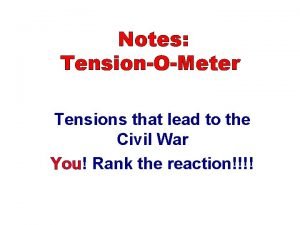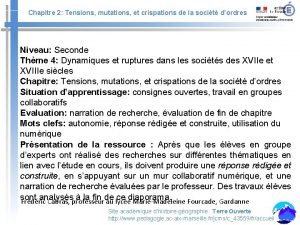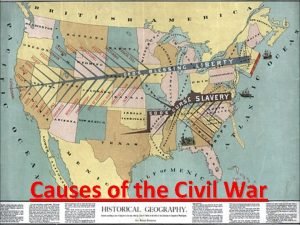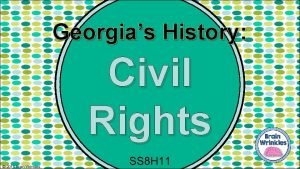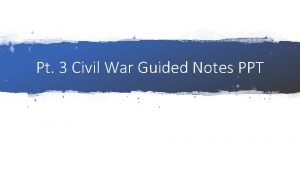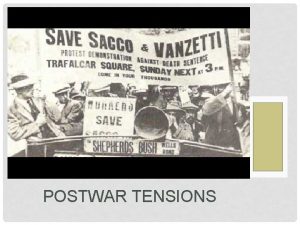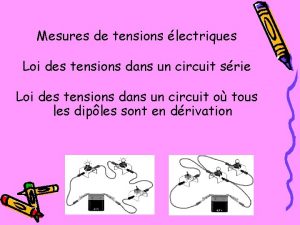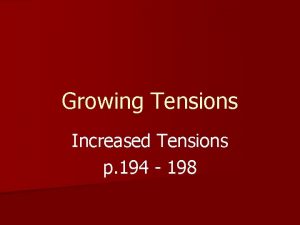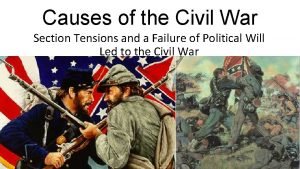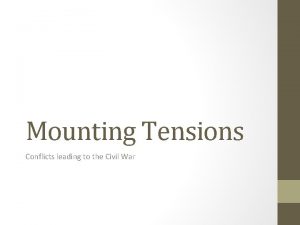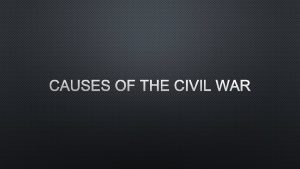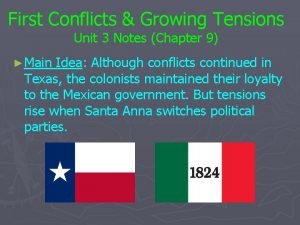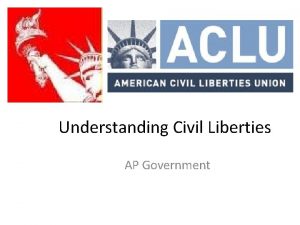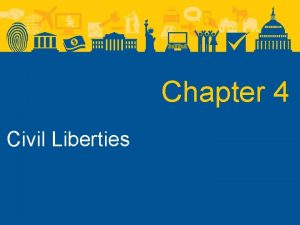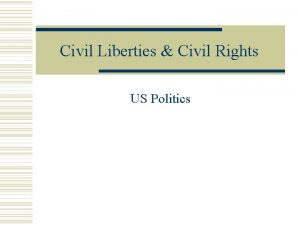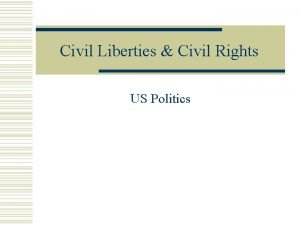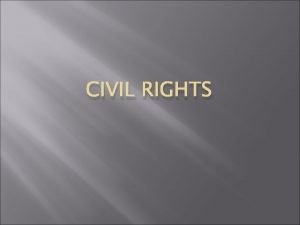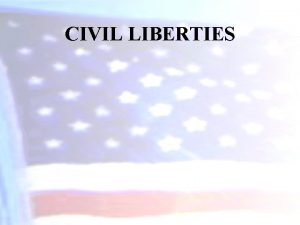Notes TensionOMeter Tensions that lead to the Civil











































- Slides: 43

Notes: Tension-O-Meter Tensions that lead to the Civil War You! Rank the reaction!!!!

Frederick Douglass • Escaped slave • A leader of the anti-slavery group in Mass. • Published a newspaper called the “North Star. ” • He worked for African American rights and was against slavery. N= X 2 -3 S= X 2 -3


Missouri Compromise 1820 • Maine enters as a “free state”, and Missouri enters a “slave state. ” • Desire to maintain balance of free and slave states as more states entered the union. ? ? • Imaginary line drawn for slavery 36º 30º latitude line prohibited slavery north of the line (south of line could have slavery). • Eased tensions- neither side happy N= X 1 S= X 1


Compromise of 1850 • The Compromise of 1850 was a group of laws passed by Congress. (Henry Clay’s idea) • 1. California enters as a “free state”. • 2. Mexican Cession was divided into twoterritories( Utah, New Mexico) and popular sovereignty would decide whether they were free or not. • 3. Stricter Fugitive Slave Law. • 4. Forbid buying and selling of slaves in the District of Columbia. Eased tensions/neither happy N= X 1 S= X 1


Personal Liberty Laws • Fugitive Slave Law= citizens had to help federal officers catch runaway slaves. • Legislatures in the Northern states passed personal liberty laws: forbid people to help slave owners find runaway slaves. • This made enforcing the Fugitive Slave Law almost impossible. N= X 3 S= X 3


Uncle Tom’s Cabin 1852 • Harriet Beecher Stowe wrote a book called, Uncle Tom’s Cabin, which reflected her hatred of slavery. • It became popular in the North (300, 000 copies sold), but banned in the South. • Southerners accused that the views about slavery were exaggerated. N= X 3. 5 -4 S= X 4




Kansas Nebraska Act 1854 • Stephen A. Douglas wanted to build railroad through the Kansas Nebraska Territory-makes deal with the South • Allow slavery in K &N territory? • Popular Sovereignty would be used to decide slavery in K&N territories. • Ended Missouri Compromise/both sides unhappy! Violence erupts! N= X 3 S= X 1 -2?



Bleeding Kansas • Race to see who would settle Kansas first, the abolitionists, or the proslavery settlers. • They did this so they could vote for or against Kansas being a free or slave state(popular sovereignty). • In May of 1856, proslavery settlers attacked the free-soil headquarters. • 200 people were killed, given the name “Bleeding Kansas”. N X 4 s X 4


Republican Party 1854 • formed in 1854 -determined to stop the spread of slavery in the territories. • Strength in the North • Lost election of 1856 -not enough strength to win majority of electoral votes N= X 3 S= X 3


Dred Scott Decision 1857 • Dred Scott was a slave, was brought from Missouri to a free state(IL, WI). • When his owner died, Scott sued the court to become a free man. • Supreme Court Ruled: 1. slaves were property 2. slaves could not sue in court 3. slavery was legal anywhere-all territories N= X 4 S= X 4


John Brown at Harper’s Ferry 1859 • Slavery became the most important issue (late 1850’s). • John Brown dreamed of freeing all Southern slaves. • Took over federal arsenal (guns and ammo). at Harper’s Ferry VA, where he tried to lead a rebellion(held out for 2 days)/lost and was hanged. • Many viewed the attack as being foolish, but others saw Brown as a hero! N= X 1? S= X 4




Election of Lincoln 1860 • Democratic vote split between Douglass and Breckinridge (favored secession) • Northern Demos voted Douglas • Southern Demos voted Breckinridge • New party: Constitutional Union Party nominated John Bell • Lincoln (Republican) wins in electoral college N= X 4 S= X 4



Secession 1860 • Dec. 20, 1860, South Carolina drops out of the Union • MS, FL, AL, TX, GA, LA • February 1861 -6 other states leave the Union • Jefferson Davis elected President N= X 4 S= X 4



Fort Sumter 1861 • Federal fort in S. C. • Confederacy took over fort April 12, 1861 • Lincoln sends reinforcements • First shots fired by South • Civil War starts • VA, TN, AK, NC-leave the Union N= X 4 S= X 4



WIO Causes of the Civil War Spectrum Make a spectrum on your paper from and Least to Most. List the 13 events that lead to the American Civil War on the spectrum and a one sentence summary of the event and why it caused high/low tensions Most tension/upset Middle of conflict Least/Eased tensions Write a one sentence summary of each issue







 Tensionometer
Tensionometer Tôn thất thuyết là ai
Tôn thất thuyết là ai Phân độ lown ngoại tâm thu
Phân độ lown ngoại tâm thu Chiến lược kinh doanh quốc tế của walmart
Chiến lược kinh doanh quốc tế của walmart Gây tê cơ vuông thắt lưng
Gây tê cơ vuông thắt lưng Block nhĩ thất độ 1
Block nhĩ thất độ 1 Tìm độ lớn thật của tam giác abc
Tìm độ lớn thật của tam giác abc Sau thất bại ở hồ điển triệt
Sau thất bại ở hồ điển triệt Thơ thất ngôn tứ tuyệt đường luật
Thơ thất ngôn tứ tuyệt đường luật Hãy nói thật ít để làm được nhiều
Hãy nói thật ít để làm được nhiều Thơ thất ngôn tứ tuyệt đường luật
Thơ thất ngôn tứ tuyệt đường luật Who made
Who made Tensions mutations et crispations de la société d'ordres
Tensions mutations et crispations de la société d'ordres Civil rights webquest
Civil rights webquest Northwest ordinance lead to civil war
Northwest ordinance lead to civil war Lead magnesium niobate
Lead magnesium niobate Civil rights cloze notes 1
Civil rights cloze notes 1 Civil rights cloze notes
Civil rights cloze notes Civil war guided notes
Civil war guided notes Conversion notes brutes en notes standard wisc 5
Conversion notes brutes en notes standard wisc 5 Vẽ hình chiếu vuông góc của vật thể sau
Vẽ hình chiếu vuông góc của vật thể sau điện thế nghỉ
điện thế nghỉ Một số thể thơ truyền thống
Một số thể thơ truyền thống Môn thể thao bắt đầu bằng chữ đua
Môn thể thao bắt đầu bằng chữ đua Công thức tính thế năng
Công thức tính thế năng Hình ảnh bộ gõ cơ thể búng tay
Hình ảnh bộ gõ cơ thể búng tay Sơ đồ cơ thể người
Sơ đồ cơ thể người Bảng số nguyên tố lớn hơn 1000
Bảng số nguyên tố lớn hơn 1000 đặc điểm cơ thể của người tối cổ
đặc điểm cơ thể của người tối cổ độ dài liên kết
độ dài liên kết Chó sói
Chó sói ưu thế lai là gì
ưu thế lai là gì Tư thế ngồi viết
Tư thế ngồi viết Cái miệng bé xinh thế chỉ nói điều hay thôi
Cái miệng bé xinh thế chỉ nói điều hay thôi Thế nào là hệ số cao nhất
Thế nào là hệ số cao nhất Trời xanh đây là của chúng ta thể thơ
Trời xanh đây là của chúng ta thể thơ Slidetodoc
Slidetodoc Từ ngữ thể hiện lòng nhân hậu
Từ ngữ thể hiện lòng nhân hậu Tư thế ngồi viết
Tư thế ngồi viết Thứ tự các dấu thăng giáng ở hóa biểu
Thứ tự các dấu thăng giáng ở hóa biểu Thẻ vin
Thẻ vin Các châu lục và đại dương trên thế giới
Các châu lục và đại dương trên thế giới Glasgow thang điểm
Glasgow thang điểm Hươu thường đẻ mỗi lứa mấy con
Hươu thường đẻ mỗi lứa mấy con
